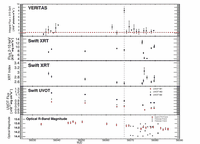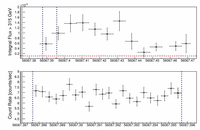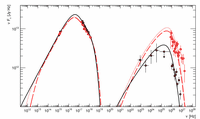VERITAS collects evidence of non-standard physical emission process through the observation of the extreme gamma-ray emitting galaxy 1ES 1959+650. Simultaneous observations of 1ES 1959+650 with VERITAS and Swift X-ray telescope show the source to display bright flares in the very high energy gamma-ray band which occurred without any change in X-ray emission from the source. Nominally, in sources similar to 1ES 1959+650 (known as blazars), the gamma-ray and X-ray emission should vary in tandem. 1ES 1959+650 has displayed this odd variability pattern in the past, known as an "orphan" gamma-ray flare. This variability pattern, although unexpected, can be understood as the source containing a relativistic population of particles within the jet that is made of a different mix of electrons and protons than other, more standard blazar galaxies.
Figure 1: The VERITAS-measured spectra of 1ES 1959+650 averaged over both dark-runs and excluding the flaring period (MJD 56034-56079; green) and during the flare (MJD 56067; red). The spectrum measured over both dark-runs (without the data from 56067) is used for the low state of the SSC modeling. The spectra are shown with 1σ statistical errors. The power-law fitting results are summarized in Table 1.

Figure 2: Broadband observations of 1ES 1959+650 in April and May of 2012. The top panel shows VERITAS integral flux values above 315 GeV, denoting 95% confidence upper limits with downward pointing arrows. The flux points are shown with 1σ statistical error bars. A line denoting 10% Crab Nebula above the same threshold is denoted by the red dotted line. The day of the VHE flare (MJD 56067) is denoted by a grey dotted line. In the two panels below this, the Swift XRT flux and spectral indices are shown. During the flare, VERITAS observed a maximum flux of 10 times the average flux of the darkrun, lasting less than two hours, with no change observed simultaneously in the X-ray flux as observed by the Swift XRT. The W1, W2 and M2 bands from UVOT exposures similarly show no evidence of increased UV flux during the VHE flare. In the bottom panel are shown observations in the R and V bands from the Super-LOTIS and iTelescope.

Figure 3: In the top panel, the VHE flux of 1ES 1959+650 above 315 GeV as observed by VERITAS on MJD 56067 in ten-minute time bins. The flux points are with with 1σ statistical error bars. The red-dotted line represents 10% Crab Nebula flux above the same threshold. The start and end of the simultaneous Swift observations are denoted with dotted blue lines (spanning 12 minutes). In the bottom panel, the Swift XRT 0.3-10 keV count rate is shown over the simultaneous observation interval.

Figure 4: The high energy gamma-ray light curve of 1ES 1959+650 as observed by Fermi LAT. Analysis is completed over four weeks on both a daily and weekly basis from MJD 56054 through MJD 56082. Upper limits are calculated from epochs where the TS value is less than 9, which was every day in the four week window, as well as the bin corresponding to the last week. There is no indication of detected high-energy gamma-ray variability during this time period. The time corresponding to the elevated state of the VHE data is highlighted by the grey dotted line.

Figure 5: Broadband SED of 1ES 1959+650 with data from MJD 56064 (black) and MJD 56067 (red). The VHE spectrum for the low state is represented by the average spectrum measured over the two dark runs, excluding the state on MJD 56067. These data are explored with a SSC representation, where the black line corresponds to the low state and the red dashed and dotted lines correspond to the high gamma-ray state observed on MJD 56067. The dotted line is produced by increasing the emission region size and low-energy cutoff, while the magnetic field is decreased. The dashed line representation is obtained by increasing the Doppler factor and keeping the emission region size constant, in addition to increasing the low energy cutoff and decreasing the magnetic field. All parameter values used in the modeling of each state are summarized in Figure 5.






